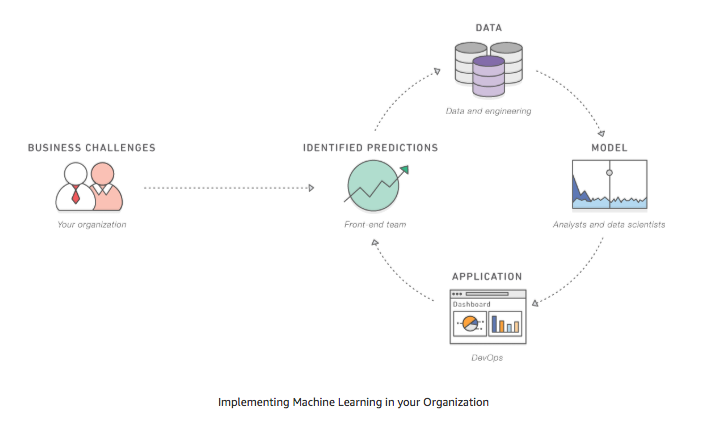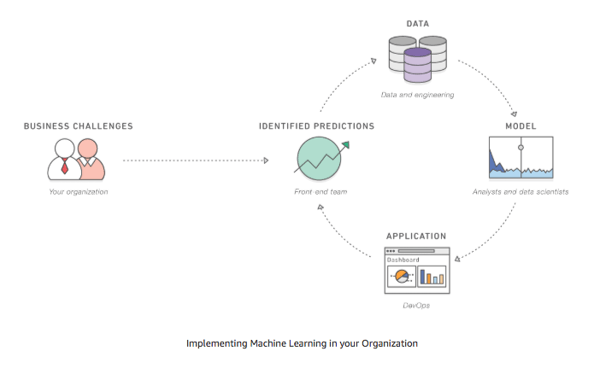
Artificial Intelligence (AI) is the field of computer science dedicated to solving cognitive problems commonly associated with human intelligence, such as learning, problem solving, and pattern recognition. Artificial Intelligence, often abbreviated as "AI", may connote robotics or futuristic scenes, AI goes well beyond the automatons of science fiction, into the non-fiction of modern day advanced computer science.
Machine learning (ML) and Deep learning (DL) are both computer science fields derived from the discipline of Artificial Intelligence.
Broadly, these techniques are separated into “supervised” and “unsupervised” learning techniques, where “supervised” uses training data that includes the desired output, and “unsupervised” uses training data without the desired output.
AI becomes “smarter” and learns faster with more data, and every day, businesses are generating this fuel for running machine learning and deep learning solutions, whether collected and extracted from a data warehouse like Amazon Redshift, ground-truthed through the power of “the crowd” with Mechanical Turk, or dynamically mined through Kinesis Streams. Further, with the advent of IoT, sensor technology exponentially adds to the amount of data to be analyzed -- data from sources and places and objects and events that have previously been nearly untouched.
Machine Learning
Machine Learning is the name commonly applied to a number of techniques used for pattern recognition and learning. At its core, machine learning is a collection of algorithms that can learn from and make predictions based on recorded data, optimize a given utility function under uncertainty, extract hidden structures from data and classify data into concise descriptions. Machine Learning is often deployed where explicit programing is too rigid or is impractical. Unlike regular computer code that is developed by software developers to try to generate a program code-specific output based on given input, machine learning uses data to generate statistical code (an ML model), that will output the “right result” based on a pattern recognized from previous examples of input (and output, in the case of supervised techniques). The accuracy of an ML model is based mainly on the quality and quantity of the historical data.
With the right data, an ML model can analyze high dimensional problems with billions of examples, to find the optimal function that can predict an outcome with a given input. ML models can usually provide statistical confidence on predictions, as well as on its overall performance. Such evaluation scores are important in the decision if you are to use an ML model or any individual prediction.
How is Machine Learning used at Amazon.com?
Amazon.com is building a lot of its business on machine Learning-based systems. Without ML, Amazon.com couldn’t grow its business, improve its customer experience and selection, and optimize its logistic speed and quality. Amazon.com started AWS to allow other business to enjoy the same IT infrastructure, with agility and cost benefits, and now continues to democratize ML technologies to the hands of every business.
The structure of Amazon.com development teams, and the focus on ML to solve hard pragmatic business problems, drives Amazon.com and AWS to develop simple-to-use and powerful ML tools and services. These tools are first tested in the scale and mission critical environment of Amazon.com, before they are exposed as AWS services for every business to use, similar to other IT services.
Implementing Machine Learning in your business
Machine learning is often used to predict future outcomes based on historical data. For example, organizations use machine learning to predict how many of their products will be sold in future fiscal quarters based on a particular demographic; or estimate which customer profile has the highest probability to become dissatisfied or the most loyal to your brand. Such predictions allow better business decisions, more personal user experience, and the potential to reduce customer retention costs. Complementary to business Intelligence (BI), which focuses on reporting past business data, ML predicts future outcomes based on past trends and transactions.
There are several steps that comprise a successful implementation of ML in a business. First, identifying the right problem -- identifying the prediction that would benefit the business if ascertained. Next, the data must be collected, based on historical business metrics (transactions, sales, attrition, etc.). Once the data is aggregated, an ML model can be built based on that data. The ML model is run and the prediction output of the model is applied back to the business system to make more informed decisions.

Machine Learning Use Cases
Anomaly Detection
Identify items, events or observations which do not conform to an expected pattern or other items in a dataset.
Fraud Detection
Build predictive models that help identify potentially fraudulent retail transactions, or detect fraudulent or inappropriate item reviews.
Customer Churn
Find customers who are at high risk of attrition, enabling you to proactively engage them with promotions or customer service outreach.
Content Personalization
Provide a more personalized customer experience by using predictive analytics models to recommend items or optimize website flow based on prior customer actions.
What is Deep Learning?
Deep Learning is a branch of machine learning that involves layering algorithms in an effort to gain greater understanding of the data. The algorithms are no longer limited to create an explainable set of relationships as would a more basic regression. Instead, deep learning relies on these layers of non-linear algorithms to create distributed representations that interact based on a series of factors. Given large sets of training data, deep learning algorithms begin to be able to identify the relationships between elements. These relationships may be between shapes, colors, words, and more. From this, the system can then be used to create predictions. Within machine learning and artificial intelligence, the power of deep learning stems from the system being able to identify more relationships than humans could practically code in software, or relationships that humans may not even be able to perceive. After sufficient training, this allows the network of algorithms to begin to make predictions or interpretations of very complex data.
Deep Leaning Use Cases
Image and Video classification, segmentation
Convolutional Neural Networks out-perform humans on many vision tasks including object classification. Given millions of labeled pictures, the system of algorithms is able to begin identifying the subject of the image. Many photo-storage services include facial recognition, driven by Deep Learning. This is central to Amazon Rekognition, Amazon Prime Photos and Amazon's Firefly Service.
Speech Recognition
Amazon Alexa and other virtual assistants are designed to recognize a request and return a response. While understanding voice is something that humans can do at a very young age, it is only recently that computers have been able to listen and respond to humans. Varying accents and speech patterns in humans make this a difficult machine task to complete utilizing more traditional math or computer science. With Deep Learning, the system of algorithms can more easily determine what was uttered and the intent.
Natural Language Understanding
Recommendation Engines
Online shopping often involves personalized content recommendations related to items you might like to purchase, movies you might want to watch, or news you might be interested in reading. Historically, these systems were powered by humans creating associations between items. However, with the advent of Big Data and Deep Learning, humans are no longer necessary since algorithms can now identify the items that might interest you by examining your past purchases or product visits, and comparing that information to that of others.
Source: https://aws.amazon.com/machine-learning/what-is-ai/


